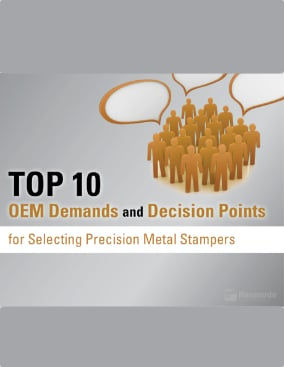Now that we’ve settled into the new year it’s the perfect time to reflect on 2018 and think about what trends are likely to influence decisions you make in 2019. Most experts agree that 2018 was a great year for manufacturing in general and specifically for products that include metal stamping components. But, what will 2019 bring?
As buyers of metal stamped parts review their options, it’s important to watch trends both inside and outside of the factory. Changing economic policies, investments in technology, and reshoring can have a significant impact on the suppliers you choose to partner with.As we start 2019, here are a few trends worth following:
Economic Forecasts and Trade Agreements
As investors bid good-bye to 2018, a stressful year marked by stock market corrections, rising interest rates, and a trade battle, they are expecting manufacturing through 2021 to remain steady. According to Fabtech, organizers of North America’s largest metal forming, fabricating, welding and finishing event:
“Manufacturing in the U.S. has successfully adapted to changes in customer needs and shifts in the competitor landscapes, while still focusing on profit margins and revenue growth. Production in the U.S. is estimated to grow 2.8 percent from 2018-2021 (a faster increase than other segments of the general economy), and manufacturing continues to have an outsized influence on regional economies”
Obviously, this is good news for U.S. stampers, but what economic issues should manufacturers watch?
Tariffs and trade agreements are always a point of interest for anyone who buys metal stamped parts, as they often affect the cost of raw materials. The United States, Canada, and Mexico reached a trade agreement relatively quickly during the 4thquarter of 2018. Most experts anticipate that the United States-Mexico-Canada Agreement (USMCA) will be ratified during the first quarter of this year. In the meantime, metal stampers and manufactures are anxiously awaiting the ongoing resolution of the steel and aluminum tariffs to determine how it will impact costs.
Reaching an agreement with China will likely dominate the discussion during the next several months. Both the US Administration and Chinese Ministry of Commerce have painted a positive picture, stating they will seek to formulate a deal. A compiler and publisher of industrial information stated:
“On the trade front, tariffs remain a top concern for manufacturing executives, though a 90-day truce between China and the United States has given the sector a little breathing room”
Some buyers of metal stampings worry that volatile long-term relations between the U.S. and China might affect long term pricing contracts, which has pushed many manufactures to consider alternative sources.
Reshoring
Reshoring is another trend buyers of metal stampings are watching, as partners look to move production closer to the end user in 2019.
The primary driver behind reshoring is the rising cost of outsourcing, which has made moving back to North America more appealing for suppliers and manufactures of products primarily consumed in the United States. Many organizations find that moving operations to the United States reduces the risk of rising labor wages, along with decreasing transportation costs, and limiting market volatility risks.
As the trend of reshoring continues, companies are enhancing their capabilities and embracing new technologies to remain competitive, which brings us to our next trend - technology.
Technology
Metal stampers are preparing to compete in 2019 and beyond by investing in technologies and automated manufacturing processes to build efficient and affordable operations. Over the past few years, the supply of skilled workers hasn’t kept pace with the rapid growth in production. This shortage has driven forward thinking metal stampers to invest in technology. Many are buying equipment and software to boost the productivity of their existing workforce.
- ERP - With labor forces stretched to their limits metal stampers and manufacturers are looking for opportunities to streamline and reduce waste. ERP systems help metal stamping companies communicate better, deliver goods to customers faster, improve productivity, and control inventories. During 2019 expect to see the digitization of manufacturing continue.
- Automation - Automation has changed the nature of many industries including precision metal stamping. Automating critical processes like production and assembly systems help businesses optimize their operations and reduce costs. As robotics technology continues to improve, automation is one of the trends that metal stampers are set to embrace in the coming years to enhance productivity and further increase the precision of parts and components.
To continue to deliver innovative, high-quality products to their clients, manufacturers must remain on top of the trends. For many, partnering with a metal stamper who acts on opportunities and invests in the future success of the supply chain insures a steady flow of quality components.
To learn more about how to choose the best custom metal stamper for your business, download Kenmode’s eBook “Top Ten OEM Demands and Decision Points for Selecting Precision Metal Stampers.”


